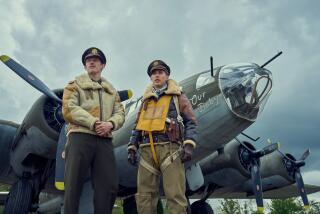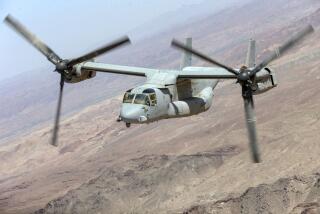‘Textbook’ Campaign by Cooks, Pilots
- Share via
Maj. Gen. Royal N. Moore Jr., commander of the El Toro-based 3rd Marine Aircraft Wing, said in an interview Sunday that he “couldn’t be more proud” of the pilots and their crews from Tustin, El Toro and the rest of the Marine Corps.
“They were told to do a job and they did just that,” said Moore, who is in charge of all Marine air power in the Persian Gulf. “I couldn’t be more proud of the wing. From the cooks to the bakers, right up to the pilots and the guys who refueled the fighters--they performed magnificently.”
In the telephone interview from Jubail, Saudi Arabia, Moore hinted that if Iraq abides by the conditions of the cease-fire and launches no more Scud attacks, some elements of his 16,000-Marine force could be heading home “rather soon.” But he warned that his fighters could be back in the air “loaded for combat” in an hour or so, if necessary.
Moore, known for his straight-talking, no-nonsense approach, showed little esteem for his Iraqi foes in his assessment of the war.
“These guys were just a bunch of thugs,” Moore said in a static-filled conversation that often faded in and out. “They deserved, in essence, everything they got.”
“If there were any surprises, it was how relatively easy the war went,” Moore also said. “It was surprising how few casualties we took, both in the air and on the ground. It was really a textbook war. The enemy just didn’t have his heart in it. We took away his eyes and ears along with his communications. Right before the cease-fire, it was clearly just a rout.”
Moore said the 3rd Marine Aircraft Wing played a significant role in defeating Saddam Hussein’s armed forces.
The wing’s aircraft, including F/A-18s from El Toro, took out missile defenses and radars early in the air war and flew missions deep into Iraq to hit strategic targets, along with planes from the U.S. Air Force and the Navy, Moore said. At the same time, Marine F/A-18s, AV-8 Harriers and A-6 Intruders were preparing the battlefield for the eventual ground war.
During the ground war, Moore said, the fighters and Cobra helicopter pilots paved the way for the 1st and 2nd Marine divisions to march to Kuwait city. “That is where we began to press real, real hard,” Moore said.
To build the flying force in the Persian Gulf, the Marines brought aircraft from bases in Tustin, El Toro, Camp Pendleton, Yuma, Ariz., Cherry Point, N.C., Hawaii and Japan. When all was said and done, the Marines had more than 450 jet fighters, observation planes and helicopters in the Middle East.
Moore said losses were minimal, and the few that the wing did suffer were because of “the so-called lucky B-B.” He likened that to the one Scud round that hit an Army barracks near Dhahran, killing 28 soldiers.
Moore said that despite the “textbook” campaign, his units met some unanticipated problems.
On the third day of the ground war, as he walked to the tactical air center, Moore said he felt the wind in his face, an indication that the weather had turned. When the wind comes off the Gulf, he said, it brings in fog and low-hanging clouds, forcing fighter-bombers to conduct the war at low altitudes, within range of SAM missiles and anti-aircraft fire.
“We got at least four (F/A-18) Hornets hit with missiles, but they all got back home safely,” Moore said. “One of them was hit twice in both engines but still flew about 125 miles to get safely back to the base. We got a lot of rounds bounced at us and in many cases we got hit, but we got everyone home.”
Moore credited his Cobra helicopters, stationed at Camp Pendleton, with destroying 14 tanks and 18 armored personnel carriers in one battle. CH-53 and CH-46 helicopters from Tustin were charged with carrying troops and “enormous loads of water, ammunition and food,” Moore said, He added that at one point, the helicopters were used to fly Iraqi prisoners south because the prisoners “were really clogging up the battlefield.”
Moore said there was disappointment among some of the fighter pilots because they had so little air-to-air combat with enemy planes. Moore said he talked “long and hard” to his pilots, telling them that they would act as bombers, not air-to-air fighter pilots, during the war.
“They swallowed hard but they knew it was true,” Moore said. “And that was the way it turned out.”
More to Read
Sign up for Essential California
The most important California stories and recommendations in your inbox every morning.
You may occasionally receive promotional content from the Los Angeles Times.













